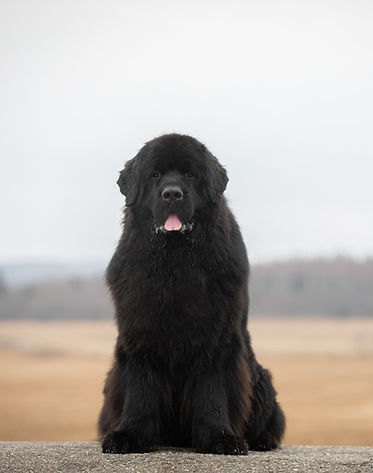
Get to know Newfoundlands
The Newfoundland is a large, strong dog breed from Newfoundland. They were originally used as a working dog to pull nets for fishermen and haul wood from the forest.
They’re a capable and hardworking dog, well suited to work on land or water. They’re a strong swimmers, sweet-natured and responsive, they make a wonderful family companion as well.
I want you to know
Surely you remember Nana, the fictional Newfoundland employed as a nanny by the Darling family in Peter Pan?
(Later, which we may remember better today, the Nana dog was represented by a St. Bernard dog, but in the beginning it was the author's Newfoundland dog.)
Sweet-natured Nana was first introduced to the public by Scottish novelist and playwright J. M. Barrie in his 1904 play, Peter Pan, which later became the well-loved kids’ story we know today.
It’s true that Barrie’s fictional account of Nana as a round-the-clock babysitter stretches reality a bit. However, there is truth in the author’s characterization of the dog.
The Newfoundland really is a sweet dog who loves children. He’s naturally gentle and friendly with them, as well as protective. Fans of this breed say the Newfoundland really is a natural-born babysitter.
The Newfoundland is known for his sweet disposition. He’s like a big, loveable Teddy Bear. He loves children, is intelligent, and aims to please (well, it depends on the state of mind..). He’s happiest when he is with his family, and should not be left alone for long periods of time or be banished to the backyard. The Newfoundland is preciously cheerful and resourceful and known for its genuine friendliness and calmness. Newfies expression reflects benevolence and gentleness. However, the image of a teddy bear being dragged along rarely comes true, as many individuals are very active and strong-willed and, especially at a younger age, can be quite fast.
Some dogs are super low maintenance when it comes to grooming. But Newfoundlands? Not so much. Newfies shed year-round—and in order to keep their coat clean and well-maintained, you need to brush them. A lot. Like, every single day and proper washing should be done at least every two months.
If you’re looking for a “ride-or-die” kind of dog, you won’t find a breed more loyal than the Newfoundland. Newfies are known to physically place themselves between their humans and strangers as a form of protection. They’re also commonly referred to as a “nanny dog” due to their gentleness toward children in the family. That’s what we call loyalty!
When a Newfoundland comes to your home, you get a gentle giant, but also a lot of hair and possibly a lot of drool.
.jpeg)
Text quoted: dogtime.com, rover.com & hankikoira.fi
health
Newfoundlands are prone to certain health conditions. Not all Newfoundlands will get any or all of these diseases, but it’s important to be aware of them if you’re considering this breed. Here are some of the most common diseases - Hip dysplasia is a heritable condition in which the thighbone doesn’t fit snugly into the hip joint. Elbow Dysplasia is a heritable condition common to large-breed dogs. It’s thought to be caused by different growth rates of the three bones that make up the dog’s elbow, causing joint laxity. Ruptured Anterior Cruciate Ligament is a common knee injury and tends to occur in young, large dogs during play or older overweight dogs; the anterior cruciate ligament tears or ruptures resulting in a sudden lameness. Gastric Torsion: Commonly called bloat, this is a life-threatening condition that affects large, deep-chested dogs like Newfoundlands, especially if they’re fed one large meal a day, eat rapidly, or drink large amounts of water or exercise vigorously after eating. Especially in dogs that eat dry food, this is a common problem. Bloat occurs when the stomach is distended with gas or air and then twists. The dog is unable to belch or vomit to rid himself of the excess air in his stomach, and blood flow to the heart is impeded.
In addition, Newfoundland dogs could have Subvalvular Aortic Stenosis disease and dilated cardiomyopathy, which is a disease that enlarges the heart muscle.
The Finnish Newfoundland Dog Association orders the following things to be investigated in breeding dogs in order to promote the health of Newfoundland dogs:
Before boarding, the parents of the puppies must have a hip x-ray report and an elbow x-ray report issued at the age of at least 18 months, as well as an extensive breed-specific heart examination report (UÄ+EKG). The heart examination report is valid for 36 months. After this, an auscultation result that shows no signs of illness can be accepted for the dog. Auscultation is valid for 36 months. If a murmur is detected during auscultation, the dog should undergo a thorough breed-specific cardiac examination (UÄ+ECG). A dog with a proven hereditary heart disease may not be used for breeding.
Puppy from Golden Drools?
If you are looking for a loving family member and hobby friend and you promise to take good care of the dog's well-being, please contact me.
+358 50 5529838
_edited_edited.jpg)

